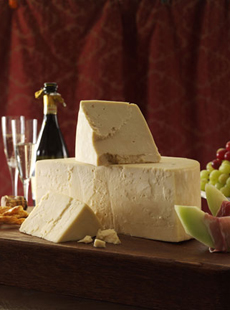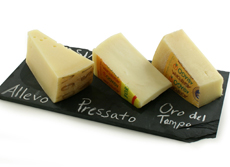

Like Grana Padano and Parmigiano Romano, Asiago is a cow’s milk cheese from northern Italy. Photo courtesy Sartori.
|
STEPHANIE ZONIS focuses on good foods and the people who produce them. KAREN HOCHMAN is Editorial Director of THE NIBBLE.
|
|
September 2007
Last Updated December 2012
|
 |
Asiago Cheese
Page 6: Asiago Cheese
This is Page 6 of an eight-page article on Italian grating cheeses; here Asiago. Click on the black links below to visit other pages.
Asiago Cheese
The alpine township of Asiago lies on a plateau of the same name in the province of Vicenza, in the Veneto region of Northeastern Italy. The semi-cooked cow’s milk cheese known as Asiago has been made there since the 16th century, when cows were brought on to the plateau to meet local preferences for cow’s milk cheese (prior to then, only sheep grazed the meadows). The neighboring region of Trentino, in the Po River Valley, has become part of the D.O.P.-designated production area for Asiago cheese.
|
|

Three different ages of Asiago: allevo (aged), pressato (fresh) and oro del tempo (extra-aged). Photo courtesy iGourmet.com. |
Asiago is almost petite compared to the big boys, Parmigiano and Grana: It’s made in mere 20-pound wheels. Asiago also differs in the variety of ripeness in which it is sold:
Asiago Pressato
Fresh Asiago, called asiago pressato, is a semisoft cheese. It can be sliced for sandwiches; the paste melts well for cheese omelets or as a sauce for vegetables. This youngest form of Asiago, produced in the Po Valley near Treviso, is mild and sweet. It has a springy, pale interior, and pairs wonderfully with a light, fruity wine.
Asiago d’Allevo
The more mature Asiago d’allevo is the grating cheese. Asiago d’allevo is sold in three “stages”: fresco (aged for two to three months), mezzano (aged three to five months) and vecchio (aged for at least nine months). Although Asiago has a straw-colored paste similar to Parmigiano and Grana, its interior contains a good number of small holes, such as you might see in a Gruyère. People from the northeastern part of Italy, more familiar with “alpine” or “mountain” cheeses such as Gruyère, may favor Asiago as their grating cheese.
Asiago d’Allevo Oro del Tempo
The costliest Asiago, this cheese has been aged for a full year under carefully monitored conditions. The sweetness and nuttiness found in the five-month Asiago d’allevo have turned to a butterscotch sweetness, with an emerging sharpness on the palate.
|
|

Linguine with olive oil, fresh parsley and roasted red peppers, garnished with grated Asiago and a fresh rosemary spear. Photo by Adam Kulesza | IST. |
Unlike the grainy Parmigiano and Grana Padano, Asiago has a smooth paste, rather like a mature Cheddar. In flavor, it is a milder cheese than Parmigiano, Grana Padano or Pecorino, with milky notes. Younger Asiagos can have aromas of yogurt and butter, the more aged Asiagos are buttery rather than sharp, with noses of yeast and dried fruit. In this way, it’s more like a mountain cheese in personality.
Wine Pairing
If you want a dry white wine option in addition to the reds above, try an Orvieto or a Soave.
Continue To Page 7: Pecorino Romano Cheese
Go To The Article Index Above
Lifestyle Direct, Inc. All rights reserved. Images are the copyright of their respective owners.

|






